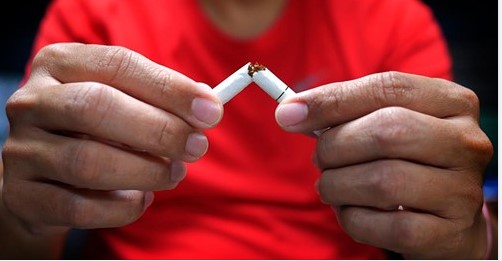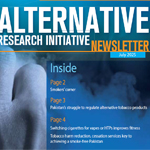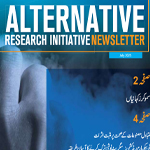 Alternative Research Initiative (ARI) works to provide researched-based solutions in a variety of social fields, including health, education, governance, culture, etc. in Pakistan. Though a new name in Pakistan's consulting sector, ARI is known for its quality research and monitoring and evaluation services.
Alternative Research Initiative (ARI) works to provide researched-based solutions in a variety of social fields, including health, education, governance, culture, etc. in Pakistan. Though a new name in Pakistan's consulting sector, ARI is known for its quality research and monitoring and evaluation services.


 ISLAMABAD: The Ministry of National Health Services, Regulations, and Coordination told the National Assembly on September 5 that the Velo nicotine pouches are non-tobacco products and do not fall under its regulatory mandate. During the question hour, the ministry clarified that it had not issued any license to any cigarette company to manufacture or the sale of Velo nicotine pouches.
ISLAMABAD: The Ministry of National Health Services, Regulations, and Coordination told the National Assembly on September 5 that the Velo nicotine pouches are non-tobacco products and do not fall under its regulatory mandate. During the question hour, the ministry clarified that it had not issued any license to any cigarette company to manufacture or the sale of Velo nicotine pouches. Every smoker faces different conditions after quitting smoking. When you quit smoking, your body and mind have to get used to not having nicotine, almost every smoker has some nicotine withdrawal symptoms. This article highlights some such symptoms and ways to prevent them. The urge to smoke is the biggest challenge for a regular smoker when trying to quit. This desire or urge may be high or low.
Every smoker faces different conditions after quitting smoking. When you quit smoking, your body and mind have to get used to not having nicotine, almost every smoker has some nicotine withdrawal symptoms. This article highlights some such symptoms and ways to prevent them. The urge to smoke is the biggest challenge for a regular smoker when trying to quit. This desire or urge may be high or low.  ISLAMABAD: The government’s decision to regularize the alternative innovative tobacco products has generated a debate on how it would affect the tobacco control initiatives in Pakistan. The federal cabinet's committee on disposal of legislative cases in its meeting on 1 December 2022 decided to regularize the heated tobacco products. The government plans to amend the law on pictorial health warning to regularize the use of heated tobacco products.
ISLAMABAD: The government’s decision to regularize the alternative innovative tobacco products has generated a debate on how it would affect the tobacco control initiatives in Pakistan. The federal cabinet's committee on disposal of legislative cases in its meeting on 1 December 2022 decided to regularize the heated tobacco products. The government plans to amend the law on pictorial health warning to regularize the use of heated tobacco products.  The Foundation for a Smoke Free World (FSFW) has a goal to advance progress in smoking cessation and tobacco harm reduction (THR) with a particular focus on LMICs. To better understand some of the challenges faced in these markets, FSFW commissioned Cambridge Design Partnership (CDP), a UK end-to-end innovation partner, to identify the barriers or impediments to adoption of electronic nicotine delivery systems (ENDS) in LMIC countries.
The Foundation for a Smoke Free World (FSFW) has a goal to advance progress in smoking cessation and tobacco harm reduction (THR) with a particular focus on LMICs. To better understand some of the challenges faced in these markets, FSFW commissioned Cambridge Design Partnership (CDP), a UK end-to-end innovation partner, to identify the barriers or impediments to adoption of electronic nicotine delivery systems (ENDS) in LMIC countries.  Tobacco consumption is a predominant cause of preventable deaths worldwide. There are 1.3 billion tobacco smokers living in low- and middle-income countries. Every year, more than 8 million people die from tobacco use; of these, more than 7 million die directly from tobacco while 1.2 million die from Secondhand Smoke (SHS). Even though all forms of tobacco are life-threatening, smoking cigarettes is the most prevalent in the world. According to the World Health Organization (WHO), the consumption of cigarettes has declined in the Americas (AMRO), the European Region (EURO), and the Western Pacific Region (WPRO). However, between 1999 and 2016, cigarette consumption increased in countries such as China (0.71 trillion), as well as the African Region (AFRO, 0.03 trillion), the Eastern Mediterranean Region (EMRO, 0.09 trillion), and the South-East Asia Region (SEARO, 0.23 trillion). According to age-standardized methods, the prevalence of daily smoking in males (25%) and females (42%) declined between 1980 and 2012, but the total number of daily smokers grew by 41% in males and 7% in females due to a rise in population growth. Read More
Tobacco consumption is a predominant cause of preventable deaths worldwide. There are 1.3 billion tobacco smokers living in low- and middle-income countries. Every year, more than 8 million people die from tobacco use; of these, more than 7 million die directly from tobacco while 1.2 million die from Secondhand Smoke (SHS). Even though all forms of tobacco are life-threatening, smoking cigarettes is the most prevalent in the world. According to the World Health Organization (WHO), the consumption of cigarettes has declined in the Americas (AMRO), the European Region (EURO), and the Western Pacific Region (WPRO). However, between 1999 and 2016, cigarette consumption increased in countries such as China (0.71 trillion), as well as the African Region (AFRO, 0.03 trillion), the Eastern Mediterranean Region (EMRO, 0.09 trillion), and the South-East Asia Region (SEARO, 0.23 trillion). According to age-standardized methods, the prevalence of daily smoking in males (25%) and females (42%) declined between 1980 and 2012, but the total number of daily smokers grew by 41% in males and 7% in females due to a rise in population growth. Read More Globally, tobacco is a major cause of more than 8 million deaths per year and a key risk factor for the development of multiple diseases, including lung, liver, oral, and throat cancers, Chronic Obstructive Pulmonary Disease (COPD), heart disease, and stroke. A large proportion of these deaths-approximately 7 million is a result of direct tobacco use while 1.2 million from exposure to secondhand smoke (SHS). The majority of smokers worldwide belong to low- and middle-income countries with different socioeconomic characteristics. Cigarette smoking increases the burden of disease and the probability of death. Historically, cigarette consumption has declined in various regions. Despite the reduced number of smokers in many countries, population growth continues to trigger an increase in cigarette consumption in China (0.71 trillion), Africa (0.03 trillion), the Eastern Mediterranean Region (0.09 trillion), and South East Asia (0.23 trillion). All these areas have distinct socioeconomic characteristics. Read More
Globally, tobacco is a major cause of more than 8 million deaths per year and a key risk factor for the development of multiple diseases, including lung, liver, oral, and throat cancers, Chronic Obstructive Pulmonary Disease (COPD), heart disease, and stroke. A large proportion of these deaths-approximately 7 million is a result of direct tobacco use while 1.2 million from exposure to secondhand smoke (SHS). The majority of smokers worldwide belong to low- and middle-income countries with different socioeconomic characteristics. Cigarette smoking increases the burden of disease and the probability of death. Historically, cigarette consumption has declined in various regions. Despite the reduced number of smokers in many countries, population growth continues to trigger an increase in cigarette consumption in China (0.71 trillion), Africa (0.03 trillion), the Eastern Mediterranean Region (0.09 trillion), and South East Asia (0.23 trillion). All these areas have distinct socioeconomic characteristics. Read More This report provides a glimpse of the tobacco landscape in Pakistan. Despite bans in recent years, there are still 24 million users of smoked and smokeless tobacco in Pakistan. Given the high levels of tobacco use, the country faces considerable health and economic consequences. Read More
This report provides a glimpse of the tobacco landscape in Pakistan. Despite bans in recent years, there are still 24 million users of smoked and smokeless tobacco in Pakistan. Given the high levels of tobacco use, the country faces considerable health and economic consequences. Read More








